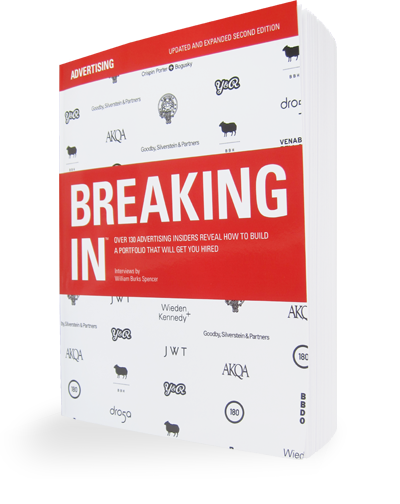Check out the work of Polly Chu.
[ … ]
The third mistake is they will present the most finished work. No matter how finished it is, you are not a professional. When we look at a student portfolio, we are not looking for professional technique. So they have a misperception about that. We’re not looking for someone to do beautiful Photoshop work. We’re looking for someone with the potential to be a very good creative thinker.
So how can we see if a person has potential? It means looking at sketches or thumbnails. It means looking at some interesting video or a non-advertising piece. If they have something very interesting, they should not be shy about showing it. Even if it is very naive and nonprofessional, they should not hide it. Just show it to us. Or if they have an interesting hobby they can put it in their portfolio.
Technique can be learned in training. Within six months or a year, a guy can start from zero and become a very professional computer operator. However, if someone is not creative, it doesn’t matter how many years you train him, he cannot get those abilities. So we’re looking for someone who is very curious about everything. He is very interesting, is interested in many things, and has a lot of lovely ideas. Show us.
Do you have any examples of the kinds of non-advertising work that people have shown to you?
There was a guy who liked to travel. So he wrote his own travel book—a travel journal—about his experiences. And he wrote it in a very naive way. The writing was lovely, and it was 100 percent better than the copy he was writing in the advertising. Another was a girl who showed me some embroidery. That was also impressive because the person who can do embroidery like that must be very patient. Sometimes this can impress us. It’s doesn’t have to be all ads and storyboards. And if the person has the right character, this is really treasured.
Do you have any other advice?
I’ll tell you a story. When I was in Shanghai, one day a young guy knocked on the door. He was a media person, but he wanted to be a creative. So I said, “How can you prove to me that you have the ability to be a creative?” Because he didn’t even have a portfolio at all. But then he showed me a notebook in which he translated all the ads from Archive magazine from English to Chinese. At that time there was no Chinese Archive. And then, he rewrote every ad, using the same visual, with his own thinking. And he told me why he thought his ideas were better. These were just thumbnails. But he was so passionate about advertising and he was trying to write in his own way.
This really impressed me. And then he said, “Since I don’t have a portfolio, what if I work here for free—you don’t need to pay me.” So I let him come in. And he would come in every day and write the leaflets, which everyone hates to do. And every day I could see that the work was improving. Every day. He wrote every sentence with passion. And after a few months, I thought, “I can’t let him go.” Even though his technique is not very mature, I thought, “I have to find a way to let him stay.” So he did, and three years later he became one of the most famous creative directors. In just three years’ time! The story behind this is that it is not the portfolio that really matters. It is the attitude that really matters. And when we look at a portfolio, it’s not about the content, it’s about the character behind it.

Polly Chu

Comments are closed.